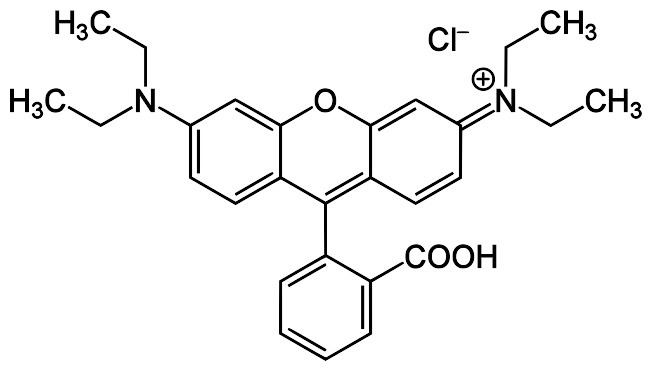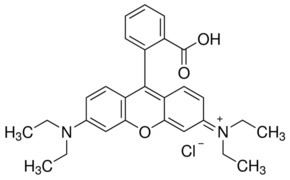 | ||
Rhodamine b
Rhodamine /ˈroʊdəmiːn/ is a family of related chemical compounds, fluorone dyes. Examples are Rhodamine 6G and Rhodamine B. They are used as dyes and as dye laser gain media. They are often used as a tracer dye within water to determine the rate and direction of flow and transport. Rhodamine dyes fluoresce and can thus be detected easily and inexpensively with instruments called fluorometers. Rhodamine dyes are used extensively in biotechnology applications such as fluorescence microscopy, flow cytometry, fluorescence correlation spectroscopy and ELISA.
Contents
- Rhodamine b
- Two photons excitation of rhodamine b with ir laser beam at 1064nm
- Rhodamine 123
- Other rhodamine derivatives
- References

Rhodamine dyes are generally toxic, and are soluble in water, methanol and ethanol.
Two photons excitation of rhodamine b with ir laser beam at 1064nm
Rhodamine 123

The laser dye rhodamine 123 is also used in biochemistry to inhibit mitochondrion function. Rhodamine 123 seems to bind to the mitochondrion membranes and inhibit transport processes, especially the electron transport chain, thus slowing down inner respiration. It is a substrate of P-glycoprotein (Pgp), which is usually overexpressed in cancer cells. Recent reports indicate that rhodamine 123 may be also a substrate of multidrug resistance-associated protein (MRP), or more specifically, MRP1.
Other rhodamine derivatives

There are many rhodamine derivatives used for imaging purposes, for example Carboxytetramethylrhodamine (TAMRA), tetramethylrhodamine (TMR) and its isothiocyanate derivative (TRITC) and, sulforhodamine 101 (and its sulfonyl chloride form Texas Red) and Rhodamine Red. TRITC is the base rhodamine molecule functionalized with an isothiocyanate group (-N=C=S), replacing a hydrogen atom on the bottom ring of the structure. This derivative is reactive towards amine groups on proteins inside cells. A succinimidyl-ester functional group attached to the rhodamine core, creating NHS-rhodamine, forms another common amine-reactive derivative.

Other derivatives of rhodamine include newer fluorophores such as Alexa 546, Alexa 555, Alexa 633, DyLight 550 and DyLight 633, HiLyte fluor 555 HiLyte 594 have been tailored for various chemical and biological applications where higher photostability, increased brightness, different spectral characteristics, or different attachment groups are needed.
